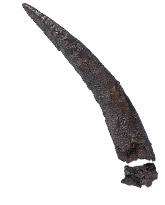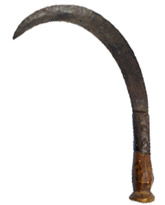“Put in the Sickle, for the Harvest is Ripe” (Joel 3: 13)
David Amit
Remains of ancient tools discovered in archaeological excavations allow us to learn about the evolution of farming culture throughout the different periods. The holiday of Shavuoth, also referred to in the Bible as the “Harvest Holiday’ and the “Day of the First Fruits”, is obviously an agricultural holiday and it was only during the time of the Second Temple did people begin to associate it with the day of the giving of the Torah. For the coming Harvest Holiday we would like to trace the development of man’s relationship with the earth through harvesting.

Iron Sickle from Ashdod, Iron Age II
In the early prehistoric periods, when the economy was based solely on hunting animals and gathering plants and wild fruit, ancient man discovered the qualities of uncultivated wheat and barley, both which are edible. This resulted in him inventing the harvesting tool which the Bible calls a scythe (in the Torah) and a sickle (in the books of the Prophets). Thus the sickle is an outstanding indicator in distinguishing between a culture of nomadic food gatherers and those that were permanently settled who were food storers, representing a more evolved culture.
The first sickles were made of an animal’s jaw bone or bowed branch in which the farmers had stuck flint blades and fastened a carved handle to the sickle so that the reaper could comfortably grasp the tool in his hand. Sickle blades are usually discovered in excavations after they have fallen out of the sickle and they are characterized by a special luster on their serrated side. This sheen is caused by the friction of the blade against the wheat and barley stalks whose fiber contains silicon. The use of metal sickles – there are a few bronze ones but most are made of iron – began in the country in the middle of the second millennium BCE, during the Bronze Age and became increasingly more popular in the Iron Age (12th-9th centuries BCE), that is the time of the First Temple.

a sickle with a wooden handle and a serrated blade
Iron sickles were found at numerous sites throughout the country dating to the days of the Second Temple and the time of the Mishnah and Talmud (the Hellenistic, Roman and Byzantine periods), as well as later periods. Noteworthy among these is a sickle with a wooden handle and a serrated blade that was discovered amongst the finds from the time of the Bar Kokhba uprising in the Cave of the Letters, in Nahal Hever in the Judean Desert. Thanks to the arid conditions of this region, the sickle was completely preserved, so much so that it can still be used.
Farm work, including the grain harvest, has always been a favorite subject for ancient mosaic artists and they depicted it in the mosaic floors in Roman villas and the synagogues and churches of the Byzantine period. Thus for example, the sickle appears as one of the items accompanying the female figures portraying the four seasons of the year in the Zodiac in the ancient synagogue at Sepphoris.